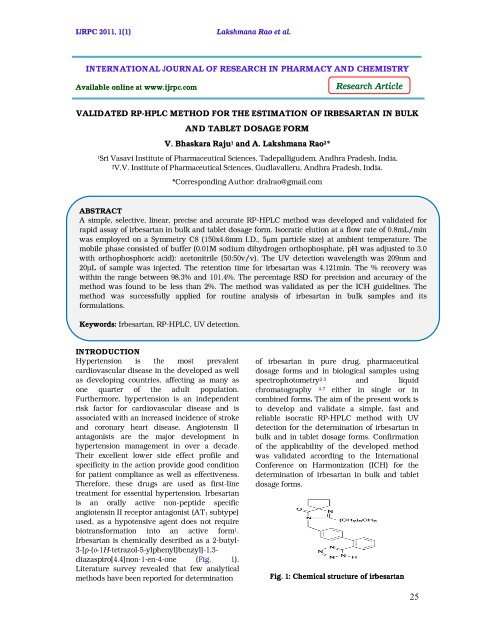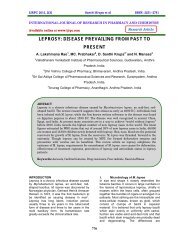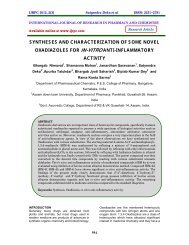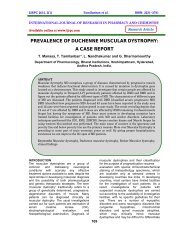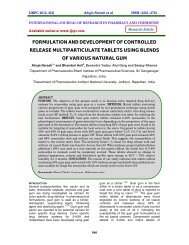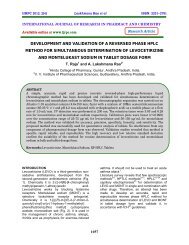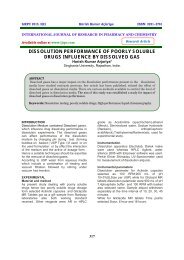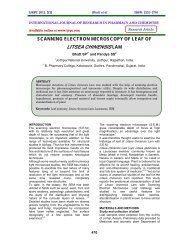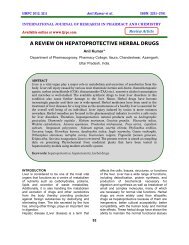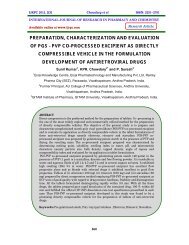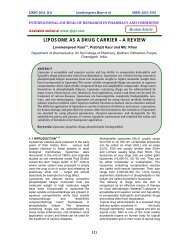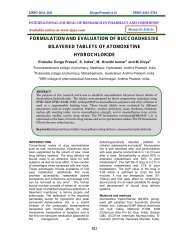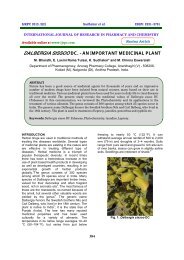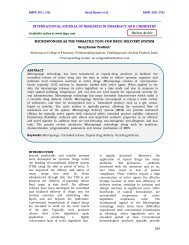Rapid Assay Of irbesartan In Bulk And Tablet Dosage Form - ijrpc
Rapid Assay Of irbesartan In Bulk And Tablet Dosage Form - ijrpc
Rapid Assay Of irbesartan In Bulk And Tablet Dosage Form - ijrpc
You also want an ePaper? Increase the reach of your titles
YUMPU automatically turns print PDFs into web optimized ePapers that Google loves.
IJRPC 2011, 1(1)<br />
Lakshmana Rao et al.<br />
INTERNATIONAL JOURNAL OF RESEARCH IN PHARMACY AND CHEMISTRY<br />
Available online at www.<strong>ijrpc</strong>.com<br />
Research Article<br />
VALIDATED RP-HPLC METHOD FOR THE ESTIMATION OF IRBESARTAN IN BULK<br />
AND TABLET DOSAGE FORM<br />
V. Bhaskara Raju 1 and A. Lakshmana Rao 2 *<br />
1Sri Vasavi <strong>In</strong>stitute of Pharmaceutical Sciences, Tadepalligudem, <strong>And</strong>hra Pradesh, <strong>In</strong>dia.<br />
2V.V. <strong>In</strong>stitute of Pharmaceutical Sciences, Gudlavalleru, <strong>And</strong>hra Pradesh, <strong>In</strong>dia.<br />
*Corresponding Author: dralrao@gmail.com<br />
ABSTRACT<br />
A simple, selective, linear, precise and accurate RP-HPLC method was developed and validated for<br />
rapid assay of <strong>irbesartan</strong> in bulk and tablet dosage form. Isocratic elution at a flow rate of 0.8mL/min<br />
was employed on a Symmetry C8 (150x4.6mm I.D., 5m particle size) at ambient temperature. The<br />
mobile phase consisted of buffer (0.01M sodium dihydrogen orthophosphate, pH was adjusted to 3.0<br />
with orthophosphoric acid): acetonitrile (50:50v/v). The UV detection wavelength was 209nm and<br />
20µL of sample was injected. The retention time for <strong>irbesartan</strong> was 4.121min. The % recovery was<br />
within the range between 98.3% and 101.4%. The percentage RSD for precision and accuracy of the<br />
method was found to be less than 2%. The method was validated as per the ICH guidelines. The<br />
method was successfully applied for routine analysis of <strong>irbesartan</strong> in bulk samples and its<br />
formulations.<br />
Keywords: Irbesartan, RP-HPLC, UV detection.<br />
INTRODUCTION<br />
Hypertension is the most prevalent<br />
cardiovascular disease in the developed as well<br />
as developing countries, affecting as many as<br />
one quarter of the adult population.<br />
Furthermore, hypertension is an independent<br />
risk factor for cardiovascular disease and is<br />
associated with an increased incidence of stroke<br />
and coronary heart disease. Angiotensin II<br />
antagonists are the major development in<br />
hypertension management in over a decade.<br />
Their excellent lower side effect profile and<br />
specificity in the action provide good condition<br />
for patient compliance as well as effectiveness.<br />
Therefore, these drugs are used as first-line<br />
treatment for essential hypertension. Irbesartan<br />
is an orally active non-peptide specific<br />
angiotensin II receptor antagonist (AT1 subtype)<br />
used, as a hypotensive agent does not require<br />
biotransformation into an active form 1 .<br />
Irbesartan is chemically described as a 2-butyl-<br />
3-[p-(o-1H-tetrazol-5-ylphenyl)benzyl]-1,3-<br />
diazaspiro[4.4]non-1-en-4-one (Fig. 1).<br />
Literature survey revealed that few analytical<br />
methods have been reported for determination<br />
of <strong>irbesartan</strong> in pure drug, pharmaceutical<br />
dosage forms and in biological samples using<br />
spectrophotometry 2-3 and liquid<br />
chromatography 4-7 either in single or in<br />
combined forms. The aim of the present work is<br />
to develop and validate a simple, fast and<br />
reliable isocratic RP-HPLC method with UV<br />
detection for the determination of <strong>irbesartan</strong> in<br />
bulk and in tablet dosage forms. Confirmation<br />
of the applicability of the developed method<br />
was validated according to the <strong>In</strong>ternational<br />
Conference on Harmonization (ICH) for the<br />
determination of <strong>irbesartan</strong> in bulk and tablet<br />
dosage forms.<br />
Fig. 1: Chemical structure of <strong>irbesartan</strong><br />
25
IJRPC 2011, 1(1)<br />
Lakshmana Rao et al.<br />
EXPERIMENTAL<br />
Chemicals and reagents<br />
HPLC grade acetonitrile, water and sodium<br />
dihydrogen orthophosphate was purchased<br />
from Merck Specialities Pvt. Ltd., Mumbai,<br />
<strong>In</strong>dia. Irbesartan standard sample was provided<br />
by Dr. Reddy’s Laboratories Ltd., Hyderabad,<br />
<strong>In</strong>dia.<br />
<strong>In</strong>strumentation and analytical conditions<br />
The analysis of the drug was carried out on a<br />
Waters HPLC system equipped with a reverse<br />
phase C8 column (150x4.6mm; 5µm), a 2695<br />
binary pump, a 20µL injection loop and a 2487<br />
dual absorbance detector and running on<br />
Waters Empower2 software. Isocratic elution<br />
with buffer: acetonitrile (50:50v/v, pH 3.0<br />
adjusted with orthophosphoric acid) was used<br />
at a flow rate of 0.8mL/min. The mobile phase<br />
was prepared freshly and degassed by<br />
sonicating for 5min before use. The UV<br />
spectrum of <strong>irbesartan</strong> was taken using a Elico<br />
SL-159 UV-Visible spectrophotometer.<br />
Stock and working standard solutions<br />
Accurately weigh and transfer 10mg of<br />
<strong>irbesartan</strong> working standard into a 100mL<br />
volumetric flask, add about 70mL of diluent and<br />
sonicate to dissolve it completely and make<br />
volume up to the mark with the same solvent.<br />
Further pipette 1mL of the above stock solution<br />
into a 10mL volumetric flask and dilute up to<br />
the mark with diluent. Mix well and filter<br />
through 0.45µm filter. The calibration curve was<br />
plotted with the five concentrations of the 5-<br />
25µg/mL working standard solutions.<br />
Chromatogram was recorded thrice for each<br />
dilution. Calibration solutions were prepared<br />
daily and analyzed immediately after<br />
preparation.<br />
<strong>Assay</strong> of <strong>irbesartan</strong> tablets<br />
Weigh 20 <strong>irbesartan</strong> tablets and calculate the<br />
average weight. Accurately weigh and transfer<br />
the sample equivalent to 10mg of <strong>irbesartan</strong> into<br />
a 100mL volumetric flask. Add about 70mL of<br />
diluent and sonicate to dissolve it completely<br />
and make volume up to the mark with diluent.<br />
Mix well and filter through 0.45µm filter.<br />
Further pipette 1mL of the above stock solution<br />
into a 10mL volumetric flask and dilute up to<br />
the mark with diluent. Mix well and filter<br />
through 0.45µm filter. An aliquot of this<br />
solution was injected into HPLC system. Peak<br />
area of <strong>irbesartan</strong> was measured for the<br />
determination.<br />
Validation procedure<br />
The objective of the method validation is to<br />
demonstrate that the method is suitable for its<br />
intended purpose as it is stated in ICH<br />
guidelines. The method was validated for<br />
linearity, precision (repeatability and<br />
intermediate precision), accuracy, specificity,<br />
stability and system suitability. Standard plots<br />
were constructed with five concentrations in the<br />
range of 5-25µg/mL prepared in triplicates to<br />
test linearity. The peak area of <strong>irbesartan</strong> was<br />
plotted against the concentration to obtain the<br />
calibration graph. The linearity was evaluated<br />
by linear regression analysis that was calculated<br />
by the least square regression method. The<br />
precision of the assay was studied with respect<br />
to both repeatability and intermediate precision.<br />
Repeatability was calculated from six replicate<br />
injections of freshly prepared <strong>irbesartan</strong> test<br />
solution in the same equipment at a<br />
concentration value of 100% (10µg/mL) of the<br />
intended test concentration value on the same<br />
day. The experiment was repeated by assaying<br />
freshly prepared solution at the same<br />
concentration additionally on two consecutive<br />
days to determine intermediate precision. Peak<br />
area of <strong>irbesartan</strong> was determined and precision<br />
was reported as %RSD.<br />
Method accuracy was tested (%recovery and<br />
%RSD of individual measurements) by<br />
analyzing sample of <strong>irbesartan</strong> at three different<br />
levels in pure solutions using three preparations<br />
for each level. The results were expressed as the<br />
percentage of <strong>irbesartan</strong> recovered in the<br />
samples. Sample solution short term stability<br />
was tested at ambient temperature (20±10 0 C) for<br />
three days. <strong>In</strong> order to confirm the stability of<br />
both standard solutions at 100% level and tablet<br />
sample solutions, both solutions protected from<br />
light were re-injected after 24 and 48hrs at<br />
ambient temperature and compared with<br />
freshly prepared solutions.<br />
RESULTS AND DISCUSSION<br />
Selection of the detection wavelength<br />
The UV spectra of <strong>irbesartan</strong> in 50:50v/v<br />
mixture of buffer and acetonitrile was scanned<br />
in the region between 200 and 400nm and<br />
shows λmax at 209nm.<br />
Optimization of the chromatographic<br />
conditions<br />
Proper selection of the stationary phase depends<br />
up on the nature of the sample, molecular<br />
weight and solubility. The drug <strong>irbesartan</strong> is<br />
non-polar. Non-polar compounds preferably<br />
26
IJRPC 2011, 1(1)<br />
Lakshmana Rao et al.<br />
analyzed by reverse phase columns. Among C8<br />
and C18, C8 column was selected. Non-polar<br />
compound is very attractive with reverse phase<br />
columns. So the elution of the compound from<br />
the column was influenced by polar mobile<br />
phase. Mixture of phosphate buffer and<br />
acetonitrile was selected as mobile phase and<br />
the effect of composition of mobile phase on the<br />
retention time of <strong>irbesartan</strong> was thoroughly<br />
investigated. The concentration of buffer and<br />
acetonitrile were optimized to give symmetric<br />
peak with short run time (Fig. 2). A short run<br />
time and the stability of peak asymmetry were<br />
observed in the ratio of 50:50% v/v of<br />
phosphate buffer and acetonitrile. It was found<br />
to be optimum mobile phase concentration.<br />
Validation of method<br />
Linearity<br />
Five points calibration graphs was constructed<br />
covering a concentration range 5-25µg/mL<br />
(Three independent determinations were<br />
performed at each concentration). Linear<br />
relationships between the peak area signals of<br />
<strong>irbesartan</strong> the corresponding drug<br />
concentration was observed. The standard<br />
deviation of the slope and intercept were low.<br />
The statistical analysis of calibration is shown in<br />
Table 1.<br />
Precision<br />
The validated method was applied for the assay<br />
of commercial tablets containing <strong>irbesartan</strong>.<br />
Sample was analyzed for six times after<br />
extracting the drug as mentioned in assay<br />
sample preparation of the experimental section.<br />
The results presented in good agreement with<br />
the labeled content. <strong>Assay</strong> results, expressed as<br />
the percentage of label claim, and was found to<br />
be 101.14 showing that the content of <strong>irbesartan</strong><br />
in tablet formulations confirmed to the content<br />
of requirements (95 – 105%) of the label claim.<br />
Low values of standard deviation denoted very<br />
good repeatability of the measurement. Thus it<br />
was showing that the equipment used for the<br />
study was correctly and hence the developed<br />
analytical method is highly repetitive. For the<br />
intermediate precision a study carried out by<br />
the same analyst working on the same day on<br />
three consecutive days (n=3) indicated a RSD of<br />
0.11. This indicates good method precision.<br />
Accuracy<br />
The data for accuracy were expressed in terms<br />
of percentage recoveries of <strong>irbesartan</strong> in the real<br />
samples. The mean recovery data of <strong>irbesartan</strong><br />
in real sample were within the range of 98.3 and<br />
101.4%. The mean %RSD was 99.4% satisfying<br />
the acceptance criteria for the study. It was<br />
proved that there is no interference due to<br />
excipients used in tablet formulation. Hence the<br />
accuracy of the method was confirmed. The<br />
results are furnished in Table 2.<br />
Stability<br />
The stability of <strong>irbesartan</strong> in standard and<br />
sample solutions containing determined by<br />
storing the solutions at ambient temperature<br />
(20±10 0 C). The solutions were checked in<br />
triplicate after three successive days of storage<br />
and the data were compared with freshly<br />
prepared samples. <strong>In</strong> each case, it could be<br />
noticed that solutions were stable for 48hrs, as<br />
during this time the results did not decrease<br />
below 98%. This denotes that <strong>irbesartan</strong> is stable<br />
in standard and sample solutions for at least<br />
2days at ambient temperature.<br />
System suitability<br />
Various system suitability parameters were also<br />
calculated. It was observed that all the values<br />
are within the limits (Table 3). The statistical<br />
evaluation of the proposed method was<br />
revealed its good linearity, reproducibility and<br />
its validation for different parameters and let us<br />
to the conclusion that it could be used for the<br />
rapid and reliable determination of <strong>irbesartan</strong> in<br />
tablet formulation. The results are furnished in<br />
Table 4.<br />
Fig. 2: Typical chromatogram of <strong>irbesartan</strong><br />
Table 1: Linearity of <strong>irbesartan</strong><br />
S. Linearity Concentration Area<br />
No. Level<br />
1 I 5µg/ml 686482<br />
2 II 10µg/ml 1327024<br />
3 III 15µg/ml 1880002<br />
4 IV 20µg/ml 2487061<br />
5 V 25µg/ml 3092080<br />
Correlation coefficient 1.000<br />
27
IJRPC 2011, 1(1)<br />
Lakshmana Rao et al.<br />
%<br />
Concentration<br />
Table 2: Recovery studies of <strong>irbesartan</strong><br />
Area<br />
Amount<br />
added<br />
(mg)<br />
Amount<br />
found<br />
(mg)<br />
%<br />
Recovery<br />
50 680637 5.1 5.17 101.4<br />
100 1315694 10.15 9.99 98.4<br />
150 1877061 14.5 14.26 98.3<br />
Table 3: System stability parameters<br />
Parameters Values<br />
λmax (nm) 209<br />
Beer’s law limit 5-25<br />
(µg/mL)<br />
Correlation 1.000<br />
coefficient<br />
Retention time 4.121<br />
(min)<br />
Theoretical plates 4276<br />
Tailing factor 1.17<br />
Limit of detection 0.01<br />
(µg/mL)<br />
Limit of 0.04<br />
quantitation<br />
(µg/mL)<br />
%<br />
Mean<br />
Recovery<br />
Table 4: <strong>Assay</strong> result of tablet formulations<br />
<strong>Form</strong>ulation<br />
Label<br />
claim<br />
(mg)<br />
Amount<br />
found<br />
(mg)<br />
%<br />
Amount<br />
found<br />
Irovel 10 10.01 99.90<br />
Xarb 10 9.98 100.20<br />
99.4<br />
CONCLUSION<br />
A validated RP-HPLC method has been<br />
developed for the determination of <strong>irbesartan</strong> in<br />
tablet dosage form. The proposed method is<br />
simple, rapid, accurate, precise and specific. Its<br />
chromatographic run time of 6min allows the<br />
analysis of a large number of samples in a short<br />
period of time. Therefore, it is suitable for the<br />
routine analysis of <strong>irbesartan</strong> in pharmaceutical<br />
dosage form.<br />
ACKNOWLEDGEMENTS<br />
The authors are thankful to M/s Dr. Reddy’s<br />
Laboratories Ltd., Hyderabad, <strong>In</strong>dia for<br />
providing a reference sample of <strong>irbesartan</strong>.<br />
REFERENCES<br />
1. www.rxlist.com<br />
2. Hisharn E and Abdellatef F. Extractive<br />
spectrophotometric determination of<br />
disopyramide and <strong>irbesartan</strong> in their<br />
pharmaceutical<br />
formulation;<br />
Spectrochim Acta A. 2007; 66:1248-<br />
1254.<br />
3. Erk N. Three new spectrophotometric<br />
methods applied to the simultaneous<br />
determination of hydrochlorthiazide<br />
and <strong>irbesartan</strong>. Pharmazie. 2003;58:543-<br />
548.<br />
4. Tutunji LF, Tutunji MF, Alzouli MI,<br />
Khabbar MH and Arida AI.<br />
Simultaneous determination of<br />
<strong>irbesartan</strong> and hydrochlorthiazide in<br />
human plasma using HPLC coupled<br />
with tandem mass Spectroscopy:<br />
Application to bioequivalence studies. J<br />
Pharm Biomed Anal. 2010;51:985-990.<br />
5. Shakya AK, Al-Hiari YM and Alhamani<br />
OO. Liquid chromatographic<br />
determination of <strong>irbesartan</strong> in human<br />
plasma. J Chromatogr B. 2007;848:245-<br />
250.<br />
6. Mbah CJ. Kinetics of decomposition of<br />
<strong>irbesartan</strong> in aqueous solutions<br />
determined by HPLC. Pharmazie.<br />
2004;59:920-922.<br />
7. Erk N. Simultaneous determination of<br />
<strong>irbesartan</strong> and hydrochlorthiazide in<br />
human plasma by liquid<br />
chromatography. J Chromatogr B.<br />
2003;784:195-201.<br />
28


